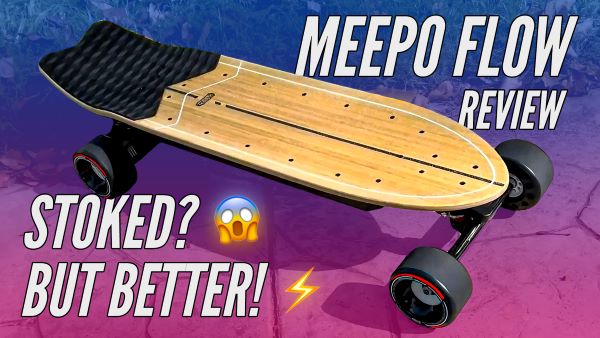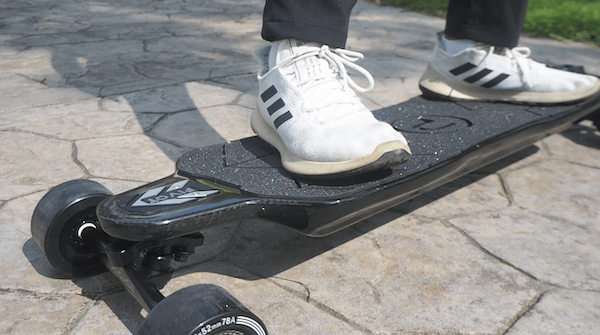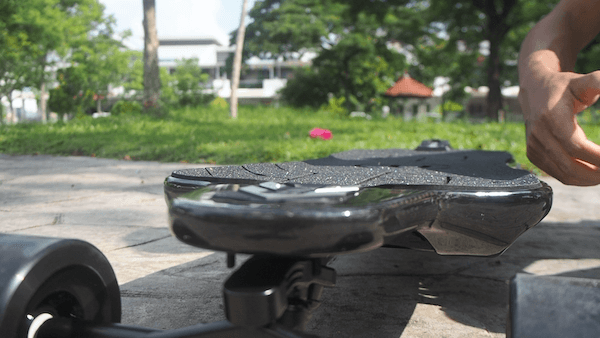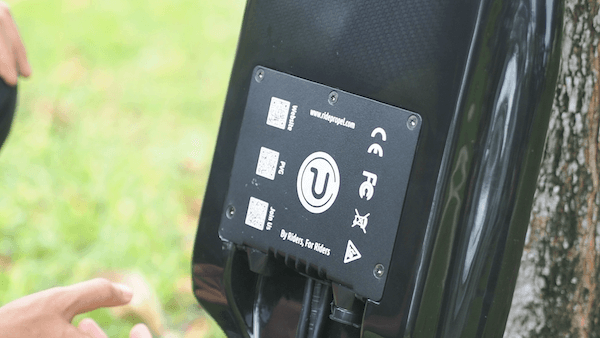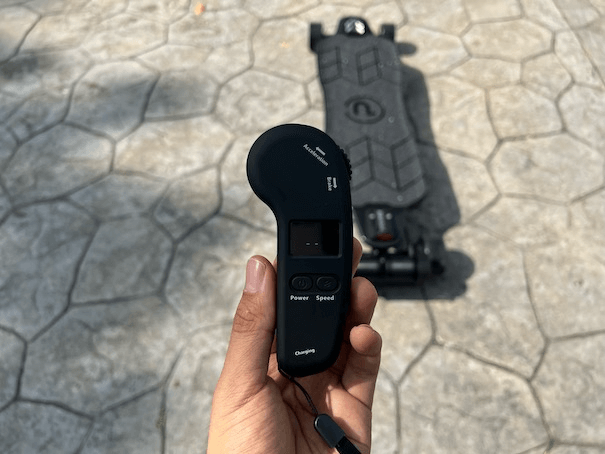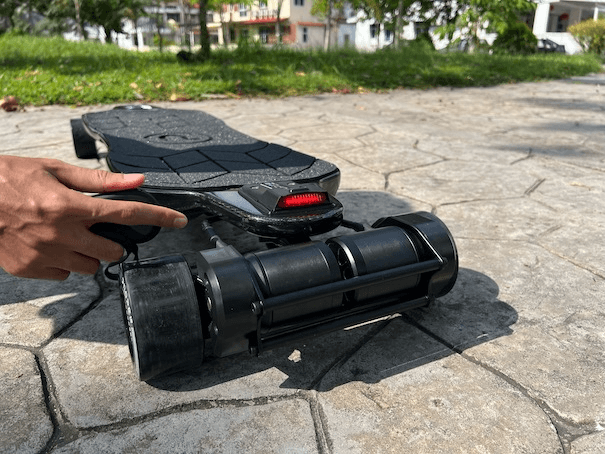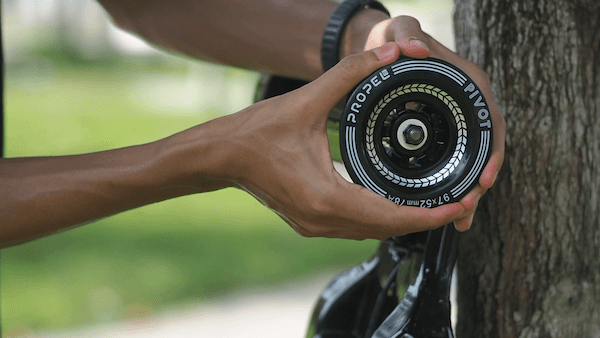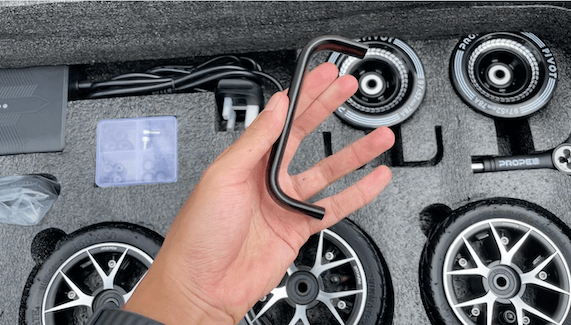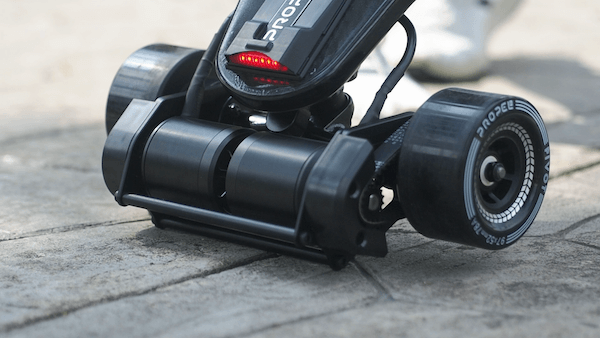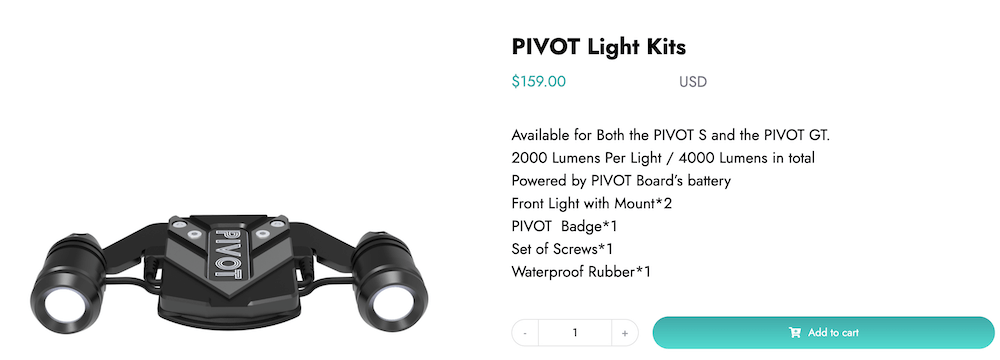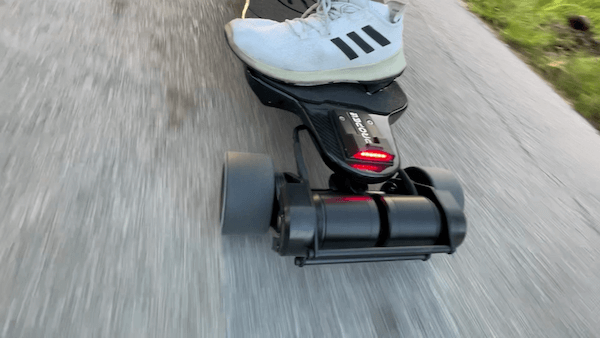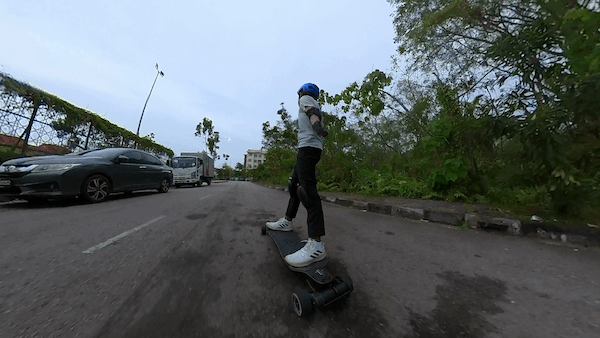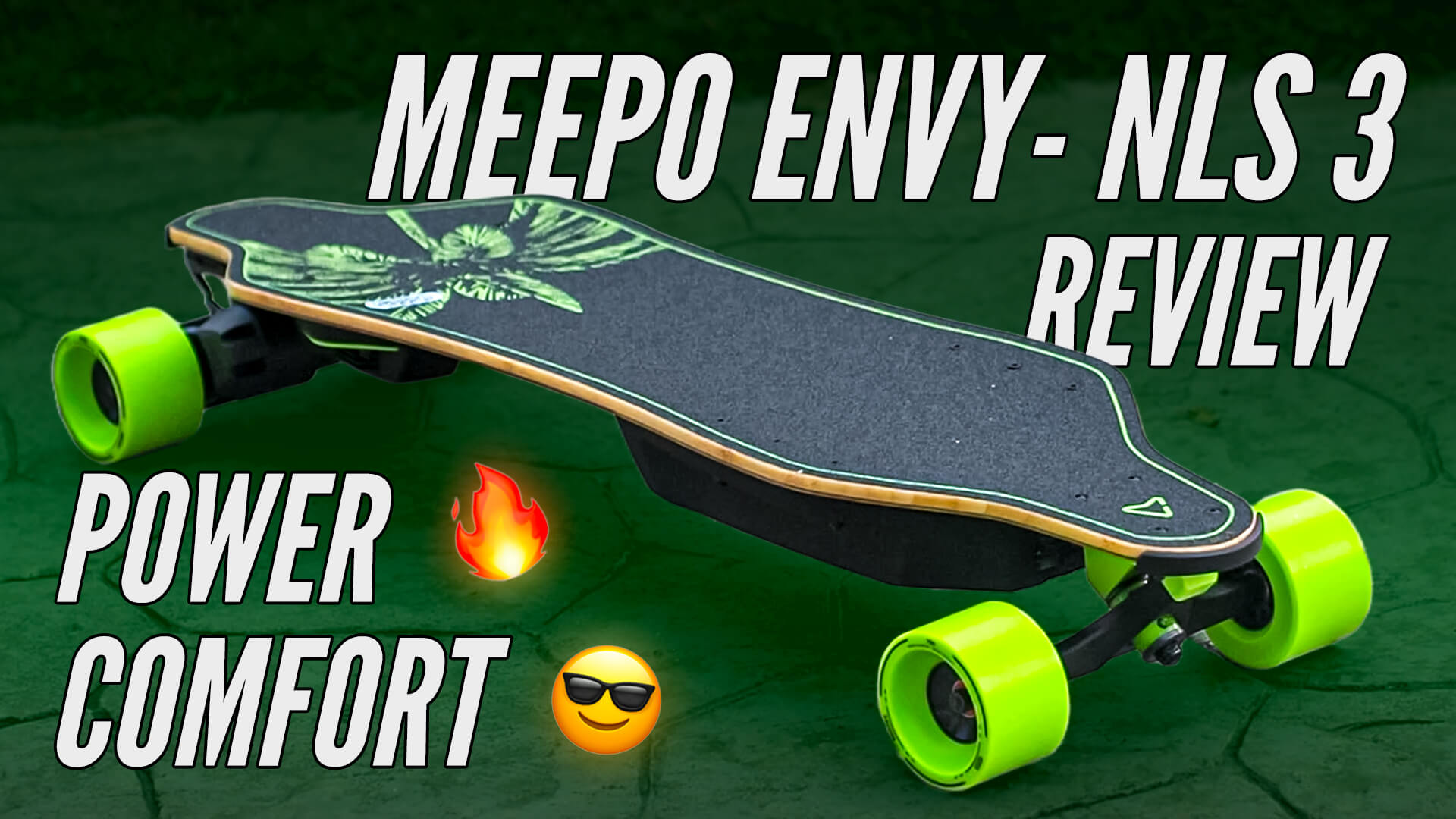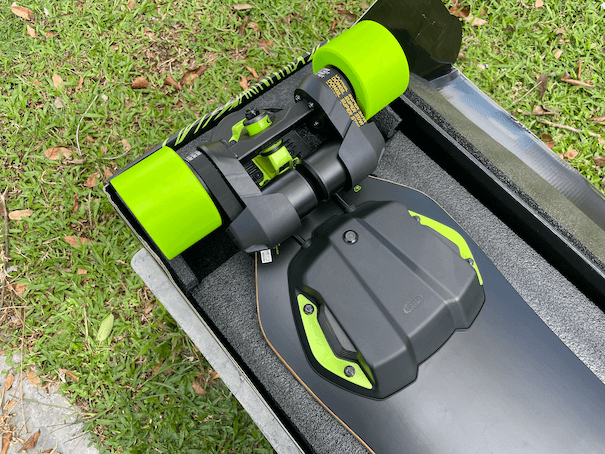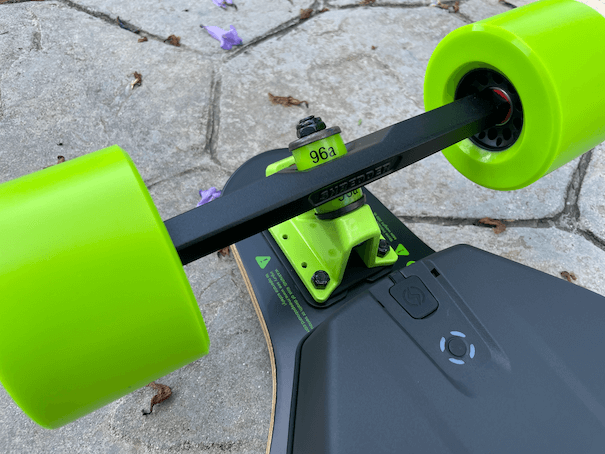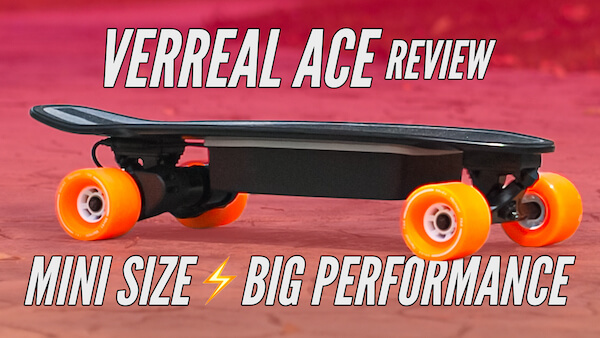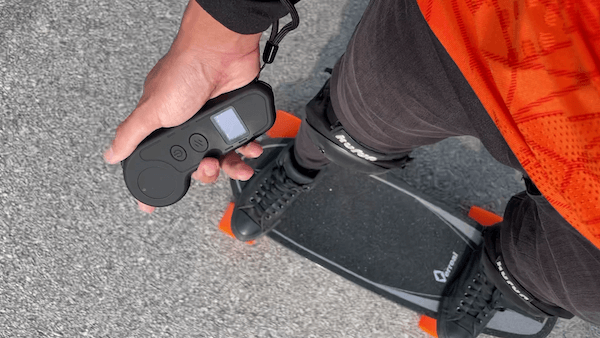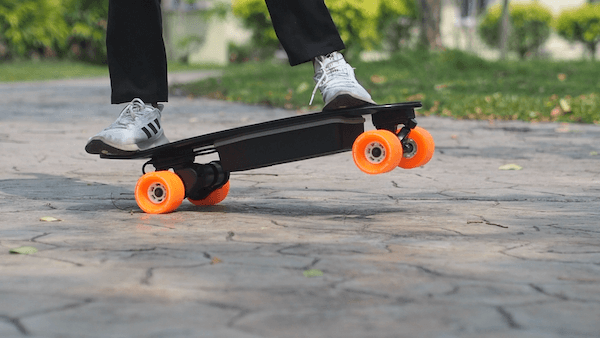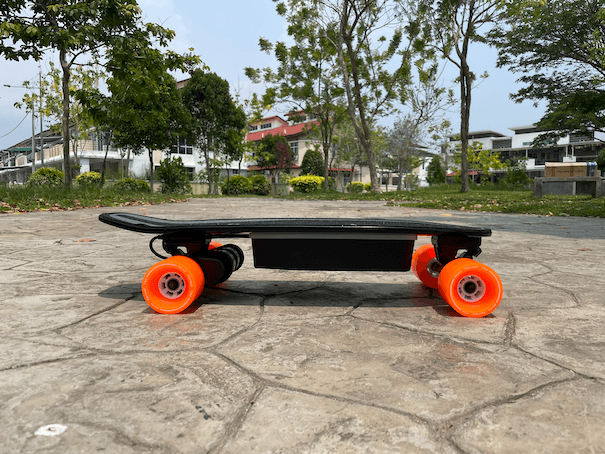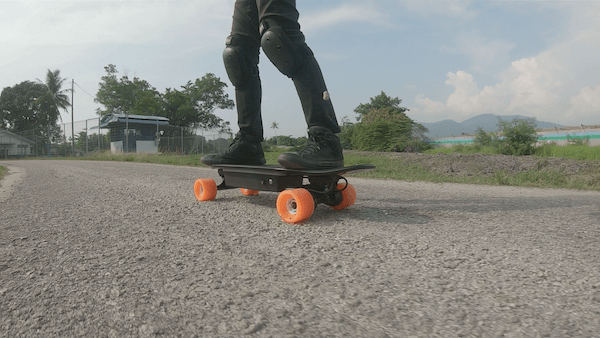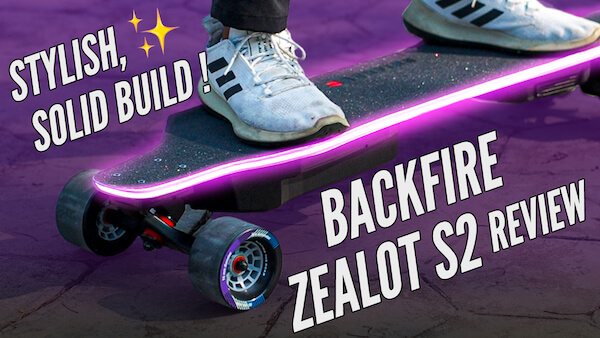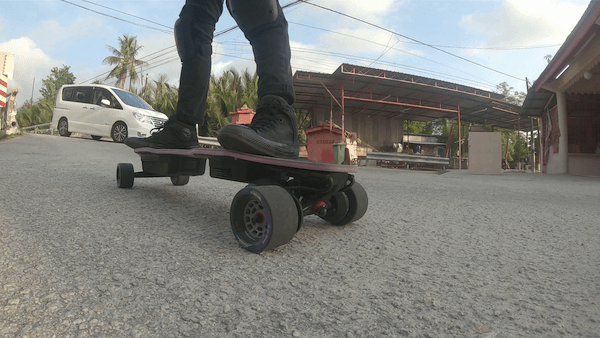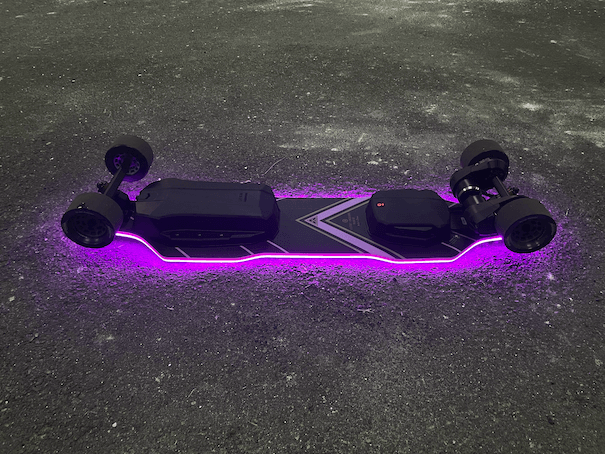Let’s first introduce the elephant in the room: Meepo Flow is the blatant copy of the Evolve Stoke, first released back in 2019. It has the exact look and uses very similar parts – a 35’ cruiser deck paired with double kingpin trucks.
However, a closer look at the specs shows that the $749 Meepo Flow might be quite a lot better than the $999 Evolve Stoke.
Specification – Meepo Flow


| Price | $749 |
| Deck | 35-inch Bamboo and fibreglass. Stiff, wide concave |
| Trucks | Double Kingpin Trucks |
| Wheels | 35-inch Bamboo and fiberglass. Stiff, wide concave |
| ESC | 12s Hobbywing ESC |
| Motors | Dual 2519W belt-drive motors |
| Battery | 12S2P, Molicel P42A, 362.8 Wh, 8.4AH |
| Top Speed | 32mph (52 kph) |
| Range | 24 miles(38 km) |
| Weight | 24.2 lbs/(11 kg) |
Deck



The Meepo Flow has the same transparent grip tape as the Evolve Stoke. It has an additional foam grip tape on the kicktail of its slightly longer 35-inch Bamboo and fiberglass composite deck. Similar to the Evolve Stoke, the Meepo deck has a wide concave and is stiff.
Looking at the photo, you might mistake the Flow as a shortboard, but at 35″ by 13.5″, it’s actually a ‘shorter’ longboard with a kicktail or a cruiser board.
Truck: Double Kingpin


The Meepo Flow is equipped with a double-kingpin truck, as per the Evolve Stoke formula. Let’s hope these trucks are good.
Wheels: OEM 105mm wheels


In contrast to the Evolve Stoke’s 85mm wheels, Meepo decided to go big with 105mm wheels. It is good to see these soft 105mm resurfaced to the market. They are the OEM wheels for the late-Boosted 105s, which Boosted previously sold at about $170 a set.
Battery: 12S2P Molicel P42A, 362Wh / 8.4AH


The Meepo Flow, like the NLS 3, has a 12S2P Molicel P42A, 362Wh / 8.4AH battery, which is significantly larger than the Evolve Stoke’s 144Wh battery. The advertised range is 23.6 miles (38km) but in our tests, we got a range of 16 miles (25.4 km) for our 155lb (70kg) rider riding fast. Again, the outcome is similar to that of the NLS 3.
Click here to read our review of the Meepo NLS 3 (AKA Meepo Envy)
ESC (Electronic Speed Controller): 12s Hobbywing ESC


The Meepo Flow uses a 12s Hobbywing ESC, which is smoother than the current-generation LingYi ESC and far superior to any ESC used by Evolve on their boards. This ESC is paired with the Meepo M4s remote, which includes a display which displays your speed and other information.
Motor: Dual 2519W belt-drive motors



This model has the same dual belt system as the NLS 3 and is far more powerful than Evolve Stoke’s dual 1500W motors. The advertised top speed is 32 mph (51.5 km h), and our tests clocked it at 30 mph.
Specs Summary of the Meepo Flow



Meepo Flow is almost the same board as the Meepo NLS 3, just with a new deck and double kingpin trucks. These are good specifications for $749, especially if you put it beside the 10s2p 144wh Evolve Stoke. But, hey, the ride experience is more important than the stats on paper, so let’s get to it.
Riding Experience


Luckily, the Flow did not disappoint. It’s a lot of fun to ride the Meepo Flow.
Speed control on the Meepo Flow is perfect, and that is no surprise at all. After all, it was using the tried and true 12s Hobbywing ESC that delivers perfectly smooth and intuitive controlsWe are also not surprised by the power that the Flow has, since it is using the same exact motors as the NLS 3, which we reviewed a while ago. Much like the NLS 3, Meepo Flow is not insanely powerful, but is powerful and comparable to any board under $900. Accelerating uphill is not gonna be a problem even for the heaviest rider.
The biggest highlight for us is definitely the cruiser deck. We don’t see cruiser boards too often, but more companies ought to make them. The board’s length is somewhere between a shortboard and a longboard. And it offers the best of both worlds; the board is stable at high speeds yet nimble for short turns. Because of the double kingpin trucks and shorter wheelbase, it can make a very tight U-turn.
These double kingpin trucks are also pretty good among the best; they clearly turn very well, as do all double kingpin trucks, but they aren’t too loose and stay stable at high speeds. We feel comfortable riding them at top speed.
Despite the weight of the board, the kicktail is easy to use, too. However, there is a flaw in this design. The motor guards will rub against the ground when you use the kicktail, so you are bound to get scratches on it.
Another highlight of the board is the 105mm wheels; now we know why the Boosted 105s were so talked about.
Amongst oversized street wheels, they’re the best we’ve tried so far at handling bumps, even better than the 105mm cloudwheels. They are also really grippy, giving the ride that nice sticky feel. If you enjoy soft wheels, you will like these 105mm wheels.
Our team generally likes big wheels because we don’t have the smoothest roads where we ride, and 105mm gives us peace of mind when riding because sticks, stones, and potholes won’t catch the wheels and send us flying.
Having 4 meaty yet soft wheels also takes away most of the road vibrations.
One big downside, though, is that the board is bulky and hard to carry around. Unlike most longboards, you can’t pull it like a suitcase, and lifting it can be a real workout. The board might be shaped like a shortboard, but it is certainly far from portable.
The Verdict



For the past 6 years, we’ve been reviewing electric skateboards, and not many have a cruiser deck. The last cruiser we reviewed was, in fact, the Evolve Stoke! It gave a fantastic ride but was overpriced for what it was. The Meepo Flow, on the other hand, is everything that the Evolve Stoke could be at a lower cost. It’s a comfortable cruiser board with 105mm wheels, has 12s Hobbywing ESC for ultra-smooth speed control, double-kingpin trucks for tight bends, and an easy-to-use kicktail.
Coming into the review, we thought the Meepo Flow was merely a cheap knockoff of the Evolve, but it turned out to be an “Evolve Stoke done right” and is now one of our favorite boards.
If you are interested in buying a Meepo, be sure to check out our affiliate discount link here and use code: “ESKATEHQ” to receive $10 off during checkout.
It will help you get a small monetary discount and help us out too. On top of that, you’ll be tagged as an Electric Skateboard HQ customer and probably be treated better. Cheers!




